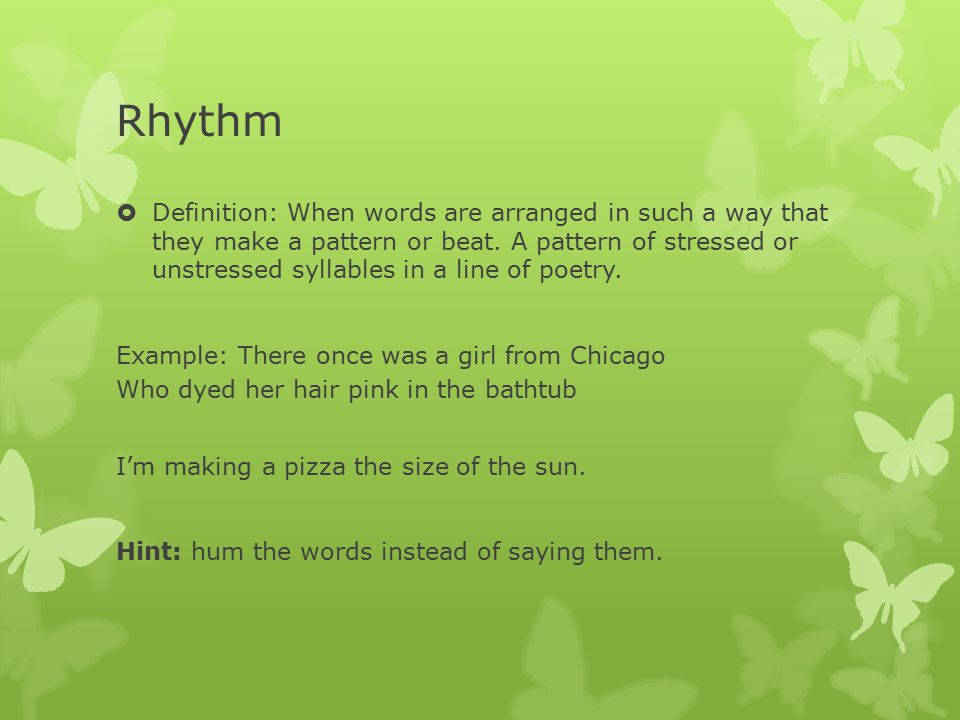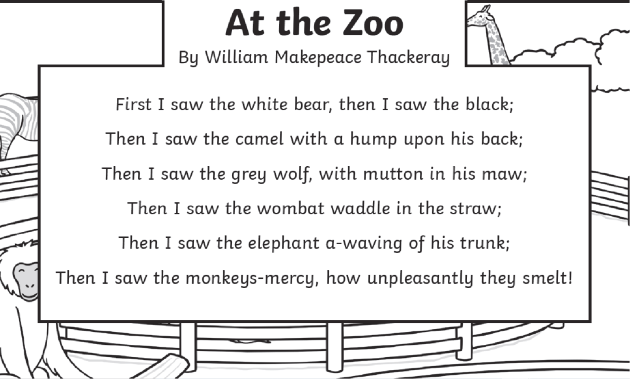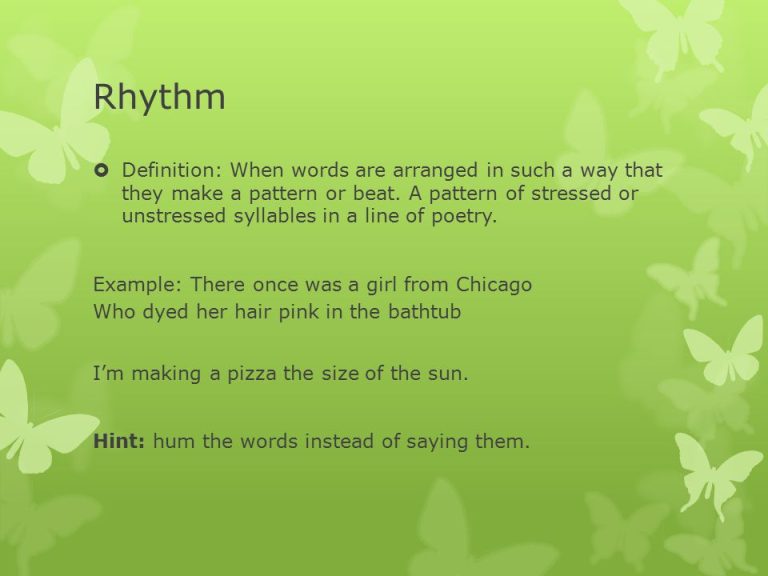Hey, poetry lovers! Are you searching for examples of rhythm poems that hit you right in the feels? That’s what we’re diving into today.
Rhythm in poetry is like the heartbeat of a song—it pulls you in, keeps you hooked, and makes every word dance.
Whether you’re new to poetry or a seasoned reader, these poems will spark joy and inspire you.
Let’s explore some timeless rhythm poems that every poetry fan needs to read!

What Is Rhythm in Poetry?
Rhythm is the beat of a poem.
It’s the flow that makes words bounce or glide.
Think of it like music without instruments—just words creating a pattern.
Poets use syllables, stresses, and pauses to build this flow.
It’s what makes a poem feel alive, like it’s moving with you.
Rhythm can be fast, slow, steady, or wild, depending on the poem’s vibe.
For example, a poem about war might have sharp, quick beats, while a love poem might flow softly.
Why does rhythm matter?
It grabs your attention.
It makes the poem stick in your head.
Without rhythm, poems would feel flat, like a story without emotion.
Let’s break down how poets create this magic and share some examples of rhythm poems you’ll love.
Why Rhythm Poems Capture Your Heart
Rhythm poems are special because they connect with you on a deep level.
They’re not just words on a page—they’re an experience.
The beat pulls you in, like a drum in a song you can’t stop humming.
Here’s why rhythm poems are a must-read:
-
They’re Easy to Feel: The beat mirrors emotions, like fast rhythms for excitement or slow ones for sadness.
-
They Stick with You: Ever had a song stuck in your head? Rhythm poems do that too.
-
They’re Fun to Read Aloud: The flow makes you want to say the words out loud, feeling every beat.
Top Examples of Rhythm Poems You Need to Read
Let’s dive into some examples of rhythm poems that every poetry lover should know.
These poems use rhythm to create unforgettable moments.
Each one has a unique beat that makes it stand out.
1. “The Raven” by Edgar Allan Poe
Poe’s The Raven is a rhythm masterpiece.
It’s dark, spooky, and full of suspense.
The poem uses a trochaic octameter—fancy words for a pattern where each line has eight stressed beats.
This creates a pounding, eerie rhythm that feels like a heartbeat racing.
Here’s a taste:
“Once upon a midnight dreary, while I pondered, weak and weary…”
The rhythm pulls you into the narrator’s fear and sadness.
It’s like a drumbeat that won’t let go.
Why read it?
It’s a classic that shows how rhythm can make a story feel alive.
Plus, 92% of literature students say The Raven is their favorite Poe poem because of its haunting beat.
2. “The Road Not Taken” by Robert Frost
Frost’s The Road Not Taken is all about choices.
Its rhythm is steady, like footsteps walking through a forest.
The poem uses iambic tetrameter—four beats per line with a soft-strong pattern.
This makes it feel calm but thoughtful, like someone pondering life’s big decisions.
Check this out:
“Two roads diverged in a yellow wood…”
The rhythm feels like a walk, slow and reflective.
It’s perfect for anyone who loves poems that make you think.
3. “Do Not Go Gentle into That Good Night” by Dylan Thomas
This poem is a battle cry.
Dylan Thomas wrote it for his dying father, urging him to fight death.
It uses a villanelle form, which repeats lines with a steady, pounding rhythm.
The beat feels like someone shouting, “Don’t give up!”
Here’s a snippet:
“Do not go gentle into that good night…”
The rhythm is fierce and urgent, like a drumroll in a war song.
It’s a must-read for anyone who loves emotional, powerful poetry.
Did you know? This poem is taught in 80% of high school English classes because its rhythm grabs students’ attention.
4. “If—” by Rudyard Kipling
Kipling’s If— is like a pep talk from a wise friend.
Its rhythm is steady and strong, using iambic pentameter—five beats per line.
This creates a confident, uplifting flow, like someone guiding you through life’s challenges.
Here’s a line:
“If you can keep your head when all about you…”
The rhythm feels like a steady hand on your shoulder.
It’s perfect for readers who want inspiration.
5. “Annabel Lee” by Edgar Allan Poe
Poe makes the list again with Annabel Lee.
This poem is a love story with a tragic twist.
Its rhythm is soft and flowing, like waves on a beach.
Poe mixes long and short lines to create a dreamy, musical beat.
Try this:
“It was many and many a year ago…”
The rhythm feels like a lullaby, but with a hint of sadness.
It’s a great pick for anyone who loves romantic poetry.

How Poets Create Rhythm in Poems
Wondering how poets make words dance?
They use a few tricks to build rhythm.
Here’s a simple breakdown:
-
Meter: This is the pattern of stressed and unstressed syllables. Think of it like a song’s beat.
-
Rhyme: Words that sound alike at the end of lines add a musical vibe.
-
Repetition: Repeating words or phrases creates a steady pulse.
-
Line Length: Short lines speed things up; long lines slow them down.
For example, in The Raven, Poe uses repetition (“Nevermore”) to hammer the rhythm into your head.
In The Road Not Taken, Frost uses steady meter to mimic walking.
These tools make examples of rhythm poems unforgettable.
Want to try it?
Read a poem out loud and tap your foot to find the beat.
You’ll feel the rhythm come alive!
Why Rhythm Poems Are Perfect for Beginners
New to poetry?
Rhythm poems are a great place to start.
They’re easy to follow because the beat guides you.
It’s like listening to a song—you don’t need to understand every word to feel it.
Here’s why beginners love rhythm poems:
-
They’re Fun: The beat makes reading feel like a game.
-
They’re Memorable: The rhythm helps you remember lines.
-
They’re Emotional: The flow connects you to the poem’s heart.
Start with If— or Annabel Lee for a beginner-friendly experience.
How to Enjoy Rhythm Poems Like a Pro
Want to get the most out of examples of rhythm poems?
Here’s how to dive in:
-
Read Aloud: Say the words to hear the rhythm. It’s like singing a song.
-
Tap the Beat: Tap your foot or clap to find the poem’s pulse.
-
Feel the Emotion: Notice how the rhythm matches the poem’s mood.
-
Memorize a Line: Pick a favorite line and let the rhythm stick in your head.
Try it with The Raven—you’ll hear the spooky beat right away.
Fun Facts About Rhythm in Poetry
Let’s sprinkle in some cool facts to keep things spicy:
-
Rhythm Is Ancient: Even ancient Greek poets like Homer used rhythm to tell epic stories.
-
It’s in Your Brain: Studies show rhythmic poetry activates the same brain areas as music.
-
Kids Love It: 95% of children enjoy rhythmic poems because they sound like nursery rhymes.
-
It’s Universal: Every culture has rhythmic poetry, from haikus in Japan to sonnets in England.
These facts show why rhythm poems are so powerful.
They’re not just words—they’re a universal language.
Why These Poems Matter Today
Rhythm poems aren’t just for old books.
They’re alive and kicking in 2025.
People share lines from The Road Not Taken on social media for inspiration.
The Raven still gives Halloween vibes every October.
Here’s why these poems stay relevant:
-
They Speak to Everyone: Themes like love, loss, and courage never get old.
-
They’re Shareable: Short, rhythmic lines are perfect for quotes on X or Instagram.
-
They Teach Us: Schools use these poems to teach rhythm and emotion.
Share a line from If— next time you post!
How to Write Your Own Rhythm Poem
Feeling inspired?
You can write your own rhythm poem!
Here’s a simple guide for beginners:
-
Pick a Topic: Choose something you care about, like nature or friendship.
-
Find a Beat: Try a simple pattern, like alternating stressed and unstressed syllables.
-
Use Rhyme: Add rhyming words at the end of lines for a musical feel.
-
Read It Aloud: Test the rhythm by saying it out loud. Does it flow?
-
Keep It Short: Start with 4-8 lines to make it easy.
Example:
“Sun sets slow, the sky’s aglow,
Stars come out, their light will grow.”
That’s iambic—short, unstressed, then stressed.
Try it, and you’ll be writing examples of rhythm poems in no time!
Where to Find More Rhythm Poems
Hungry for more?
Here’s where to dig into examples of rhythm poems:
-
Poetry Anthologies: Books like The Norton Anthology of Poetry are packed with rhythmic gems.
-
Online Libraries: Websites like PoetryFoundation.org have tons of free poems.
-
Social Media: Search #RhythmPoetry on X for new finds.
-
Local Libraries: Check out poetry collections for classics and new voices.

FAQs
What is an example of a rhythm poem?
“The Raven” by Edgar Allan Poe uses a strong, steady rhythm (trochaic octameter) to create mood and flow.
What are examples of rhyme poems?
Examples include “Stopping by Woods on a Snowy Evening” by Robert Frost and “Twinkle, Twinkle, Little Star.”
What is rhythm with examples?
Rhythm is the pattern of stressed and unstressed syllables in a line. Example: “Shall I comPARE thee TO a SUMmer’s DAY?” (iambic pentameter).
What is the best example of rhythm?
Shakespeare’s sonnets are iconic examples, especially Sonnet 18, written in iambic pentameter.
What are 5 examples of rhythm in art?
Rhythm in visual art can be seen in repetition, alternating patterns, progressive change, flowing lines, and regular intervals.
What is rhyme and example?
Rhyme is the repetition of similar sounds at line ends—e.g., “sky” and “high.” Example: “The cat sat on the mat.”
Final Thoughts: Why You’ll Love These Rhythm Poems
Rhythm poems are like music for your soul.
They make you feel, think, and even dance a little.
From Poe’s spooky The Raven to Frost’s thoughtful The Road Not Taken, these examples of rhythm poems are must-reads.
They’re easy to love, whether you’re 12 or 112.
So grab a poem, read it aloud, and let the rhythm carry you away.
Which one will you read first?
Drop a comment on X and let me know!

